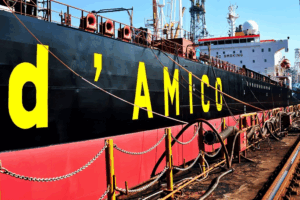The chemical tanker Bow Olympus, owned by Norwegian shipowner Odfjell, is currently crossing the Atlantic powered by a combination of wind-assisted propulsion and a certified sustainable 100% biofuel.
Odfjell states that real-time data from the voyage confirms that this dual propulsion approach is not only technically feasible, but also impactful as the vessel’s GHG emissions on the current voyage meet the 2050 Fuel EU Maritime GHG intensity targets and IMO’s GFI Direct Compliance targets at least until 2044.
The company says that the power of wind-assisted propulsion has been tested through Bow Olympus’ two first cross-Atlantic voyages, where the four 22-meter suction sails have been operational under varying weather conditions, with the performance closely monitored by Odfjell’s crew and technology team on board and onshore.
Also the use of a new type of AI-based weather routing system allowed the five-year-old 49k dwt vessel to take full advantage of the prevailing wind conditions.
In addition to the sails, Odfjell decided to double the exploration and added another element to Bow Olympus’ current Atlantic crossing with 100% sustainable biofuel. The goal was to explore a pathway towards near-net-zero operations for a deep-sea vessel. The bunkered biofuel was sourced from certified sustainable waste materials. The certification body is accredited by both IMO and EU.
Over the past decade, Odfjell has installed more than 140 energy-saving devices on its vessels, improving carbon intensity by more than 53% compared to the 2008 IMO baseline. Having exhausted most conventional upgrades, Odfjell is now stating that it is focused on next-generation solutions such as wind propulsion in order to meet its 2030 goal of 57% carbon intensity reduction, but in order to move the needle beyond 57%, a fuel switch is required.
“The results have surpassed our expectations,” confirms VP Technology Erik Hjortland. “Even in good, but not perfect, wind conditions, we observed a 15-20% energy-saving effect. That translates to five tons of fuel saved per day, equivalent to a reduction of 15 tons of CO₂ emissions per day. On certain parts of the current voyage, we have seen up to 40% fuel consumption reductions. These are very promising figures. We are thrilled to note that our initial calculations are confirmed and even exceeded.”
“One surprising finding is that even light wind as high as 15 degrees on the bow generates noticeable effect. This means that we can probably operate the sails more often than anticipated, positively affecting the already healthy return of investment figures. The sails also offer stabilizing and roll-damping effects,” says Hjortland, who also adds that “Based on current data, we expect that the sails will continue delivering significant fuel savings on future deep-sea voyages in all basins.”



